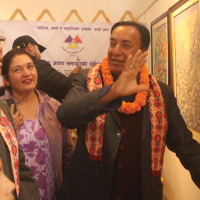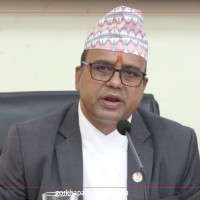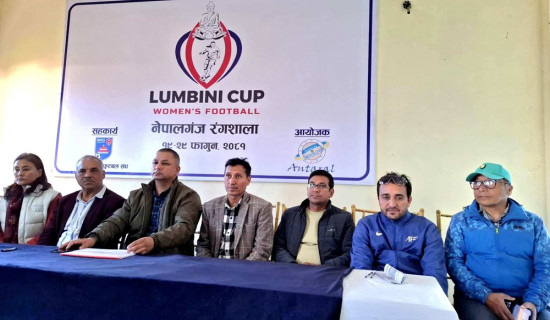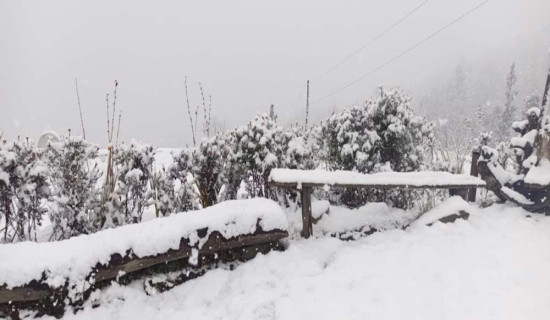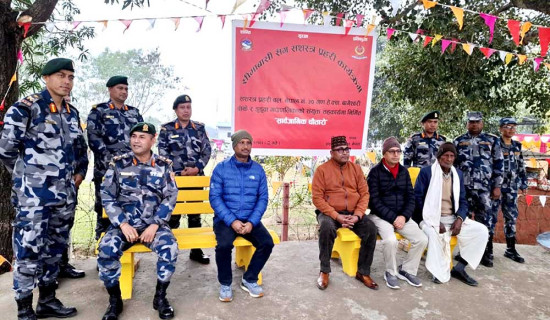- Saturday, 18 January 2025
A Tribute To 'Shatabdi Purush'
Scholar and linguist, folklorist, historian, journalist, and archaeologist! Late Satya Mohan Joshi has become these all. In his 103-year highly fulfilled life, Joshi contributed so much to Nepali literature, culture, and language that UNESCO termed him a 'living human heritage'. It was surprising for many that he lived an active life, making even the youngsters envious.
He began his professional career as an employee of the Department of Statistics under the government and was mobilised in Lamjung to collect data for the census. Meanwhile, he studied the local folklore, music, and culture of Brahmins and Chhetris in Lamjung. After returning from his field survey, he published a book 'Hamro Loksanskriti' (our folk culture) on the folk cultures of the area. His maiden book became the recipient of the first 'Madan Puraskar' in 1956. Madan Puraskar is the largest prize in the Nepali literary sector. Later, he received two more Madan Puraskars and is the only individual to receive it three times; the third was awarded jointly with Sthir Jung Bahadur Singh, BIhari Krishna Shrestha, Prof. Chudamani Bandhu, and Pradip Rimal for 'Karnali Loksanskriti' (the folk culture of Karnali). The book was published in five volumes and is the only work of such scale on the cultural life of the Karnali region. The project remains the most important project ever undertaken by the Nepal Academy so far.
The person, who had left the government-run National News Agency, later became the chancellor of Nepal Bhasha Academy. When Radio Nepal announced his name as the director of the Department of Archaeology, he couldn't believe his ears and did not contact the government for a week. That was the time! After the country was ushered into the federal system, the late Joshi was on the selection committee for the new national anthem of the country. While he was alive, he could see coins and postal stamps bearing his images. After his death, he donated his body to a teaching hospital in Kathmandu. He lives his life to the fullest and contributes immensely to the country and society.
Recognising this contribution, many articles, features, and books were written about his life. Continuing this tradition, journalist and writer Gopi Krishna Dhungana has collected articles, newspaper opinions, editorials, interviews, newspapers, and other materials and published a huge volume of more than 400 pages. This book will remain the single volume that offers most of the dimensions of the life, works, and contributions of the late Joshi.
The book contains the opinions of 32 prominent personalities, writers, and journalists on Joshi. They include Satya Mohan himself, veteran journalist Bhairab Risal, Prof. Dr. Jagman Gurung, cultural expert Dr. Govinda Tondon, the architect of his 'Shatabdi Purush' title, Narendra Raj Prasain, Dhirendra Premarshi, Dr. Gita Tripathi, CK Lal, and Maya Thakuri. Lal has chronicled his life journey, from his role as an industrial survey officer to being a Nepali language teacher in Beijing and a cultural explorer in various regions of the country. The late Joshi utilised every opportunity to tread into new territory and study cultural as well as historical facets of people and folklore. While in Beijing, China, as a language teacher, he explored Araniko, a national emblem of Nepal, which went to Tibet and then Beijing about 1200 years ago and expanded Nepali architectural beauty to the northern neighbour. He published a book on Araniko, which became the first of its kind. Lal says that his continuous effort to remain simple made him 'exceptional'.
Many label Joshi as a 'polymath', recognising his knowledge and experience in diverse fields of culture, society, and history. Probably a bonus in the book is the article on Joshy by 'National Poet' late Madhav Prasad Ghimire. He wrote the article while he was 93 years old for the magazine 'Shabda Samyojan' which published a huge volume on Joshi about a decade ago. A couple of writers have tried to explore why Joshi always wore the same topi with different colours.
From the book, we learn that the national newspapers published an editorial on Joshi. There is a collection of seven editorials and four interviews. The interviews also include philosophical aspects of Joshi's thought. Although hundreds of news stories were published about Joshi while he was alive and posthumously, only 17 are included in the anthology. It has three poems on 'Shatabdi Purush' by Saru Bhakta, Shandi Deep Rayamajhi, and Narayan Nepal.
Dhungana has put in hard work to collect about 80 write-ups from various media, books, and magazines, as well as online portals. There is a list of all the life works of the late Joshi, and six pages are filled with photos. The book is a good read. However, since many people are writing about the same person, there is a duplication of information, which will certainly not be liked by the readers.
However, the matter is beyond the control of the editor. Yet, some articles from writers like Sangita Dahal, CK Lal, and Khem Koirala Bandhu have talked about the philosophy of Joshi's life, while Laxmi Lamsal has exclusively written about his activities in Beijing and his relations with Chinese people and institutions. However, many people have talked about Joshi's 'Jureli Darshan' (bulbul philosophy), but no one has presented it in detail or the dimensions of it as conceptualised by Joshi.
(The author is a TRN journalist.)




